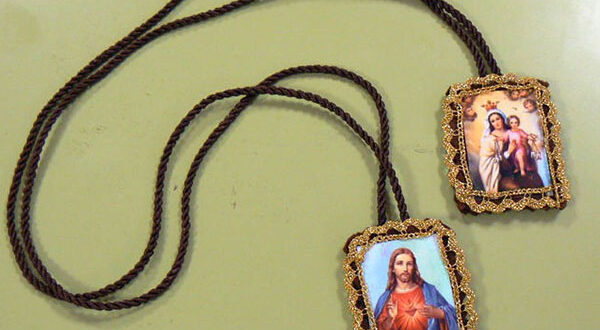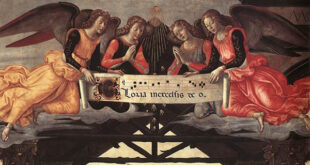In the rich tradition of the Catholic Church, the scapular holds a prominent place as one of the most profound symbols of devotion and spiritual commitment. This simple garment, often worn discreetly over the shoulders of the faithful, carries with it a deep history, theological significance, and spiritual power. But what exactly is a scapular? Where does this tradition come from, and what does it mean for Catholics today? In this article, we will explore its origins, symbolism, and the profound relationship it establishes between the believer and the Virgin Mary.
What is a Scapular?
The scapular is a devotional object that forms part of Catholic tradition, particularly associated with the Carmelite Order and Marian devotion. There are different types of scapulars, but the most well-known is the Scapular of Our Lady of Mount Carmel, also called the “brown scapular.”
In its simplest form, the scapular consists of two small pieces of cloth (usually brown) joined by two strings that are worn over the shoulders, with one piece resting on the chest and the other on the back. Although modest and simple in appearance, the scapular carries a deep meaning of commitment and divine protection. In its original form, worn by religious orders, the scapular was a full-length garment worn over the shoulders by monks and nuns. Over time, its size was reduced to allow laypeople to wear it as well.
The Origins of the Scapular: The Vision of St. Simon Stock
The history of the scapular is deeply linked to a Marian apparition. According to tradition, St. Simon Stock, an English Carmelite friar from the 13th century, received a vision of the Virgin Mary on July 16, 1251. During this apparition, the Virgin handed Simon a scapular and said:
“Receive, my beloved son, this scapular for your order. It will be a sign of salvation, a protection in danger, and a pledge of peace. Whoever dies wearing this scapular will not suffer eternal fire.”
This event marked the beginning of devotion to the scapular as a special way of consecrating oneself to the Virgin Mary and receiving her maternal protection. The Virgin’s promise, known as the Scapular Promise, offers a powerful assurance: those who wear the scapular devoutly, live a life of faith, and strive to do God’s will will receive the grace of eternal salvation.
The Symbolism of the Scapular: Faith, Protection, and Devotion
The scapular is not a charm or magical object. Its power does not lie in the cloth itself, but in what it represents and the spiritual commitment it implies for the person who wears it. At its core, the scapular is an external sign of an inner consecration. It is a tangible reminder of devotion to the Virgin Mary and of the commitment to live according to the values of the Gospel.
1. Consecration to Mary
Wearing the scapular is a visible sign of a deep Marian devotion. It is a way of spiritually entrusting oneself to the Virgin Mary, allowing her to guide our lives toward her Son, Jesus. Through the scapular, the faithful place themselves under Mary’s protective mantle, trusting in her maternal intercession. In the words of Pope St. John Paul II, who wore his own scapular from a young age: “The scapular signifies belonging to Mary; it means living by her side as her beloved child.”
2. Spiritual Protection
One of the most comforting promises associated with the scapular is that of protection in moments of danger, both physical and spiritual. Our Lady of Mount Carmel, often depicted holding the scapular in her hand, is seen as a powerful intercessor before God. Devotees believe that by wearing the scapular with faith, they receive special help from Mary in times of temptation and adversity. This protection is not only for the end of life but also throughout the daily journey of the believer.
3. Commitment to Christian Life
The scapular also implies a personal commitment. It is not enough to wear it out of tradition or habit; it calls for living according to the values of the Gospel. Mary asks those who wear her scapular to live a life of faith, love, and service. The scapular serves as a constant reminder of this call to holiness and faithful following of Christ.
The Promises of the Scapular
Over the centuries, various promises and blessings have been associated with the use of the scapular. Among the most well-known are:
- The promise of salvation: As mentioned earlier, the Virgin Mary promised St. Simon Stock that those who died wearing the scapular with devotion would not suffer the pains of hell.
- The Sabbatine Privilege: Another promise related to the scapular is the so-called “Sabbatine Privilege,” which holds that if a devotee dies in a state of grace and has faithfully worn the scapular, Mary will help free them from purgatory on the Saturday following their death.
- Special grace at the hour of death: Scapular wearers are promised special grace at the moment of death, ensuring a peaceful death and reconciliation with God.
The Scapular in Modern Life
Though the scapular has centuries of history, its relevance has not diminished in the modern world. Today, the scapular remains a source of comfort and spiritual strength for millions of Catholics around the world. In a world full of uncertainties and challenges, the scapular reminds us of the closeness of the Virgin Mary and the protective love of God.
Moreover, the scapular invites a deeper reflection on our faith. In a time where distractions and temptations are constant, wearing the scapular calls us to consciously live out our faith in every aspect of our lives. It serves as a daily reminder that we are called to a personal relationship with God, and that Mary, as Mother, walks with us on that journey.
Who Can Wear the Scapular?
The scapular is available to all baptized members of the Catholic Church and does not require a person to be part of a religious order to wear it. To receive the scapular, it is recommended to participate in an investiture ceremony conducted by a priest, during which the new wearer commits to living according to the Catholic faith and nurturing a devotion to the Virgin Mary. Once received, the scapular may be replaced by a scapular medal, which serves the same symbolic purpose.
Conclusion
The scapular is much more than a religious object; it is a profound symbol of faith, devotion, and protection. Through this humble sacramental, Catholics find a tangible means of expressing their love for the Virgin Mary and living under her protective mantle. By wearing the scapular, we commit to a life of prayer, service, and fidelity to God, while trusting in the promises of salvation and protection offered by our heavenly Mother.
Today, as centuries ago, the scapular remains a living symbol of the intimate relationship between the believer and the Virgin Mary. It reminds us that no matter the challenges we face, Mary is always present, guiding us toward her Son and offering her maternal love every step of the way.






